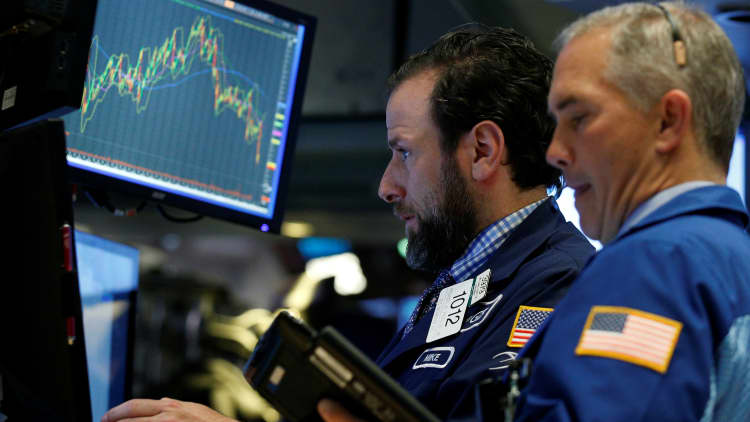
The recent spate of disappointing data shows an unpleasant truth: Americans may have to recalibrate their expectations for economic growth.
Forget Friday's stronger-than-expected report on first-quarter GDP: The quarter itself was still weak, the second quarter outlook is better but raising questions, and economic measures overall have been missing economists' expectations at a steady clip.
One measure helps show just how poorly the economy has performed compared to the Wall Street outlook.
The Citi Economic Surprise Index, which tracks actual data against predictions, is running at a 15-month low (chart by years from FactSet):
The significance of the divergence between performance and expectations is that sentiment surveys consistently have been showing high levels of optimism that the economy was about to break free of its post-financial crisis malaise. President Donald Trump's pro-growth agenda of tax cuts, lower regulation and infrastructure spending helped drive that belief, but his plans have stalled.
Unless the data start to change in a meaningful way, it could be time to put those hopes on hold.
"There might have been too much optimism as to what the hard data will deliver," said Ed Yardeni, head of Yardeni Research. "After the election ... nobody wanted to bet against (Trump's) predictions that his policies could revive economic growth to 3 or 4 percent. I think it's looking more and more like a stretch, if nothing else (because) his policies aren't going to be implemented anytime soon."
Indeed, Friday also brought news that consumer sentiment, in the closely watched University of Michigan survey, nudged lower in May and was below forecasts. That came the same morning that a revision put first-quarter GDP growth at 1.2 percent — better than the estimate but still the worst in a year.
The outlook for the second quarter is better, though economists are all over the place regarding just how much of an improvement will occur.
CNBC's Rapid Update survey of economists sees growth around 3.2 percent; the Atlanta Fed's much-discussed GDP Now tracking measure was cut Friday from 4.1 percent to 3.7 percent, while Goldman Sachs this week sliced its expectations down to 2.8 percent. Assuming the CNBC number is close to correct, that would put first-half average growth around 2.2 percent — ahead of recent pace but well short of the Trump target.
To be sure, an indicator like the Citi surprise gauge is volatile, and in fact could turn soon. However, that in itself likely would be because economists start shifting their expectations lower as it becomes clearer that 2017 will not bring that robust growth everyone was expecting.
"On a year-over-year basis, we're still doing 2 percent, which is what we've been doing since 2011," Yardeni said. "Nothing seems to have changed in that regard."
The market doesn't seem to mind
The best news to come out of the wobbly economic start is that investors don't really seem to care, or at least are willing to be patient.
Market bears have been unable to gain any ground this year, as every sell-off has been met with solid buying. It seems that so long as the economy stays above water, earnings continue to be solid and tax cuts along with the rest of the Trump agenda remain alive, however distant their enactment may be, the bull market will persevere.
"There's almost a tax-plan put under the market, just like we talked about the Fed put," said JJ Kinahan, chief market strategist at TD Ameritrade. "It's paid people to, every time the market sells off the last five, six years, to come in and buy. ... They've been paid handsomely for doing that."

Corporate profits also have been critical, Kinahan said.
Perhaps the most important gauge of surprises measured against expectations happens during earnings season, and the first quarter of 2017 provided a pleasant upside. Fully 75 percent of companies beat estimates, good for a profit increase of 13.9 percent, the best since Q3 of 2011, according to FactSet.
Earnings usually drives market performance, and the hope is that both will push the economy.
"Nobody respects the economy," Kinahan said. "I still think there are some good things happening underneath."
The final arbiter on the economy, though, is often the Federal Reserve. The central bank looks at growth and makes policy decisions accordingly. Judging by recent statements out of the Fed, it's prepared to move ahead with additional rate hikes this year as well as to begin the process of winding down its $4.5 trillion balance sheet.
Economists at Bank of America Merrill Lynch think that's a bad idea due to the data weakness, particularly regarding inflation.
"While we still believe that the data do not justify a hike at the June meeting, it seems that the Fed is committed to forging ahead," Michelle Meyer, U.S. economist at BofAML, said in a note Friday. "While Fed officials seem willing to look past the data for the June meeting, persistent weakness will be impossible to ignore."
Watch: Markets reading economic tea leaves



